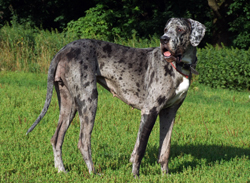Great Danes are extremely large dogs with short, thick, and glossy coats. Their coat comes in a variety of colors, including blue, black, brindle, fawn, harlequin, and mantle, and their heads are rectangular and long. These dogs have dark, medium-sized eyes that are set deep and medium-sized ears. Male Great Danes measure at least 30 inches tall at the shoulder, while females measure at least 28 inches tall. These dogs weigh 110 to 190 pounds.
Although they are gentle giants and don't bark very much, Great Danes make great watch and guard dogs. Their size alone is enough to deter most unwelcome guests.
Friendly and energetic dogs, Great Danes are popular family pets and make striking show dogs. They are gentle and loving, but their large size requires supervision around children and small animals. These dogs are easy to care for and groom, but their daily exercise requirement makes them a poor choice for busy families without much free time.
Due to their extremely large size and elegant appearance, Great Danes are sometimes referred to as the "king of dogs."
Great Danes are known for their spirited, friendly, courageous, and dependable personalities. They are never aggressive or timid, but are easygoing and sensitive. With children, they are loving and gentle, although their size may make them a hazard without supervision. These dogs make excellent family companions.
Although they are gentle giants and don't bark very much, Great Danes make great watch and guard dogs. Their size alone is enough to deter most unwelcome guests.
Despite their size, these dogs do not do well outdoors. They need a moderate amount of exercise, and therefore benefit from walks and time in a fenced yard, but they prefer to live indoors with their human family. Additionally, Great Danes need soft bedding and a large, comfortable space to stretch out in. Snuggling on the couch and watching television with their loved ones is always a good choice for a weekend activity.
Great Danes are susceptible to certain health problems that negatively affect length or quality of life. Gastric torsion, wobbler's syndrome, elbow dysplasia, congenital hip dysplasia, cataracts, OCD, hypertrophic osteodystrophy, glaucoma, and von Willebrand disease are all known to affect these dogs. Sadly, gastric torsion, which is highly preventable, is the number one killer of Great Danes, and these dogs bloat more often than any other dog breed.
Cancer is also a leading cause of death in the breed, and these dogs are at especially high risk of developing bone cancer. Great Danes also suffer from a higher than average incidence of cardiomyopathy, a type of heart disease that affects the heart muscle, resulting in an enlarged heart.
With routine veterinary care, standard canine vaccinations, attention to diet and exercise, and regular screenings for high-risk conditions, Great Danes can live as long as 13 years.
The good news is that Great Danes are generally well behaved. The bad news is that their enormous size puts everyone and everything around them at risk and makes early training absolutely essential.
These dogs are very sensitive and respond best to consistent training methods and positive reinforcement. Training should focus on preventing habitual barking and jumping on people, and care must be taken to teach these dogs that any aggression, nipping, or over-protectiveness will not be tolerated. What is easily overlooked in a small dog can prove very dangerous in a dog the size of a full-grown Great Dane.
It's important to keep these dogs physically and mentally stimulated, too. Allowing them to become bored can result in digging, countersurfing, barking, and other undesirable and destructive behaviors. Patience through the "teen" years, which in Great Danes starts at about six months and continues through two years of age, is crucial.
Although they shed moderately, Great Danes require minimal daily grooming. A weekly brushing with a soft bristle brush or rubber hound mitt is generally adequate to keep the coat and skin healthy most times of the year. During shedding season, more frequent brushing is recommended.
These dogs only need bathing when they become dirty or roll around in something harmful, and a quick wash with a pH-balanced canine shampoo will clean the coat without drying the skin. Between bathings, inspection of the feet, nose, eyes, and ears is important to look for injury or signs of infection. Great Danes with drooling problems can be wiped dry several times daily with a clean towel.
The nails need clipping every few weeks and the ears should be checked periodically for excess wax accumulation. If ear cleaning is necessary, a veterinarian-approved otic cleanser should do the job without causing pain or irritation. Also, the Great Dane's teeth should be brushed regularly to remove tartar, prevent gum disease, and freshen the breath.
Although the origins of the Great Dane breed we know and love today are traceable to Germany and to a mix of Irish Wolfhound and English Mastiff, historians claim that drawings of dogs resembling the breed date back to 3000 B.C., and that a written description of a dog that sounds very similar to the Great Dane has been found in Chinese writings of 1121 B.C.
These dogs were originally bred to hunt wild boar, a ferocious animal that needed a very large and powerful hunter. When the breed was no longer needed for its hunting skills, it became used primarily as an estate guard or companion animal. Sometime before the late 1800s, the breed made its way to the United States, where it became immediately popular due to its impressive size, elegant appearance, and lovely temperament.
No one knows exactly why the breed is called the Great Dane. There is no doubt that the breed hails from Germany, where authorities insist it be called the Deutsche dogge. The English-speaking world continues to call the breed by its original name of Great Dane.
The American Kennel Club officially recognized the Great Dane in 1887.

